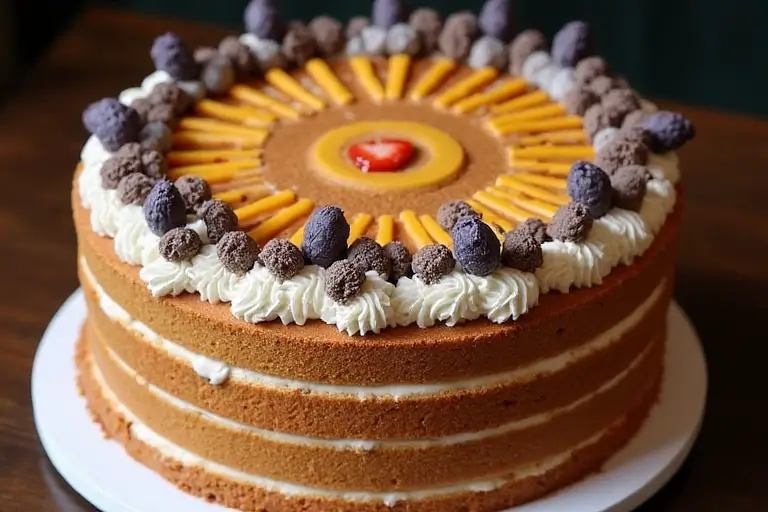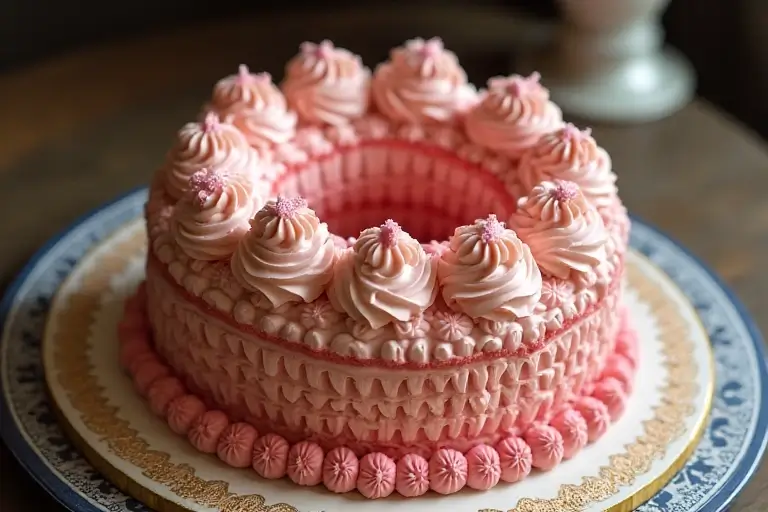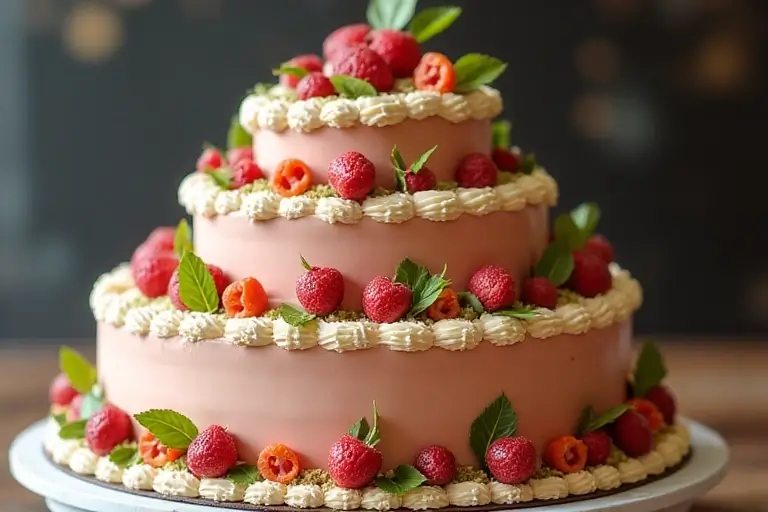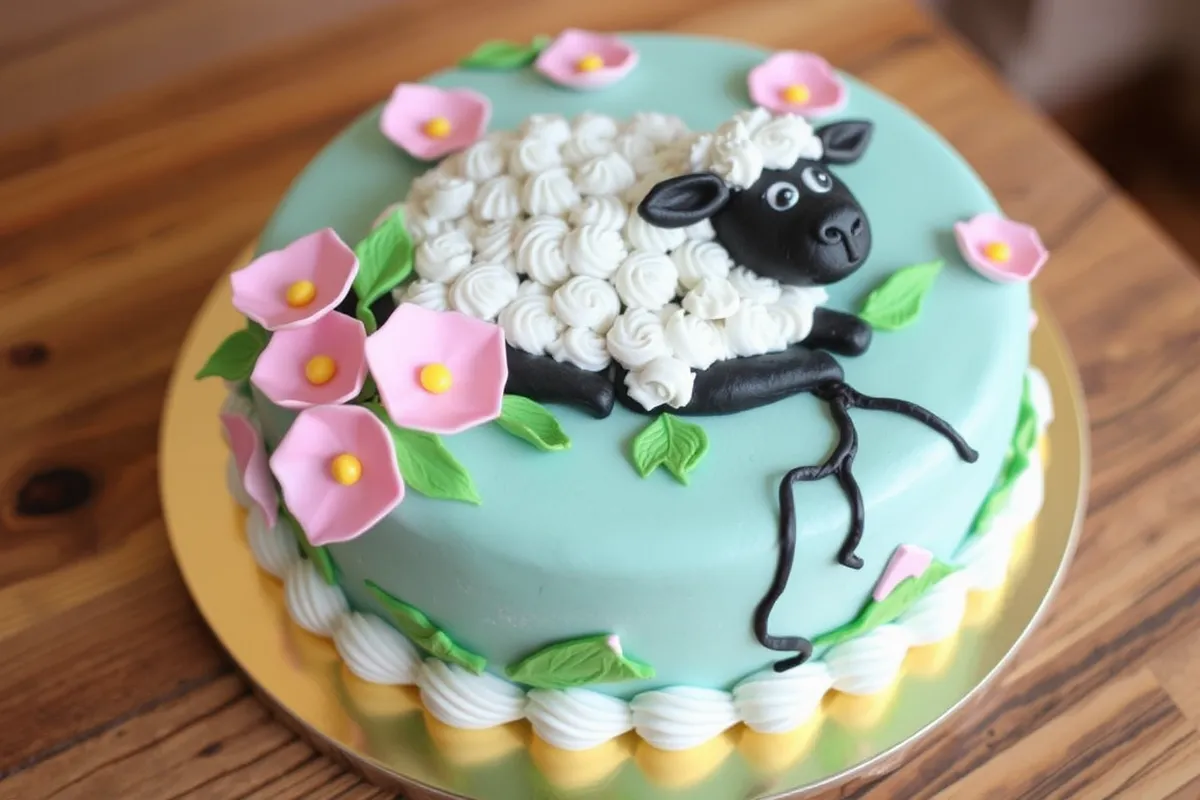This article explores the Lambeth cake, its unique features, and how to create this stunning style. We’ll also cover its history, techniques, and variations.
Understanding the Lambeth Cake Style
The Lambeth cake style is known for its elaborate piping. It involves intricate layers of buttercream, creating a design that is both visually stunning and structurally impressive. Lambeth cakes are often described as having a vintage or classic look, evoking a sense of nostalgia and old-world charm. Indeed, they are a true art form in cake decorating, showcasing the baker’s skill and attention to detail. The technique requires patience, but the results are undeniably beautiful, allowing for a high degree of creativity in the design. Moreover, it stands out among other cake designs, making it a remarkable centerpiece for any occasion.
Defining Characteristics of a Lambeth Cake
Several key characteristics define a Lambeth cake, making it easily recognizable. These include the use of multiple layers of piped buttercream, creating a three-dimensional effect. Intricate designs are a hallmark, often featuring scrolls and swags that flow gracefully across the cake’s surface. A generous use of buttercream is typical, providing the medium for these elaborate patterns. Additionally, Lambeth cakes often incorporate floral accents and other piped decorations, adding to their visual appeal. Ultimately, they possess a classic, vintage, and elegant appearance, making them a timeless choice for special celebrations.
PrintLambeth Cake: A Detailed Guide
- Total Time: 2.5 hr
- Yield: 12 servings 1x
- Diet: Vegetarian
Description
A classic Lambeth-style cake featuring rich, moist layers and elaborately piped royal icing decorations—this showstopping vintage design is perfect for weddings, birthdays, or any celebration that calls for edible elegance.
Ingredients
For the cake:
2 1/2 cups all-purpose flour
2 1/2 tsp baking powder
1/2 tsp salt
1 cup unsalted butter, softened
1 3/4 cups granulated sugar
4 large eggs
1 tbsp vanilla extract
1 cup whole milk
For the buttercream:
1 1/2 cups unsalted butter, softened
5 cups powdered sugar
1 tbsp vanilla extract
2–4 tbsp heavy cream
For the royal icing (for Lambeth piping):
3 cups powdered sugar
2 egg whites or 5 tbsp meringue powder
1/4 tsp cream of tartar
Food coloring as desired
Instructions
1. Preheat oven to 350°F (175°C). Grease and flour three 8-inch round cake pans.
2. In a bowl, whisk together flour, baking powder, and salt.
3. In a large bowl, cream butter and sugar until light and fluffy. Add eggs one at a time, then mix in vanilla.
4. Alternate adding dry ingredients and milk, beginning and ending with flour. Mix just until combined.
5. Divide batter evenly among pans and bake 25–30 minutes or until a toothpick comes out clean. Cool completely.
6. To make buttercream: Beat butter until creamy. Gradually add powdered sugar, vanilla, and cream until smooth and fluffy.
7. To make royal icing: Beat egg whites or meringue powder with powdered sugar and cream of tartar until stiff peaks form. Tint as desired.
8. Level cakes and stack with a thin layer of buttercream between each. Apply a crumb coat, chill, then cover with a smooth buttercream layer.
9. Use various piping tips and stiff royal icing to create Lambeth-style layers: scrolls, shells, over-piping, and lace effects.
10. Allow icing to set before transporting or slicing.
Notes
Lambeth-style decorating requires stiff royal icing and steady piping skills—practice ornate borders and scrolls on parchment first.
Royal icing can dry quickly; keep covered with a damp towel when not in use.
This cake holds well at room temperature for several hours or can be chilled for up to 2 days.
- Prep Time: 1 hr
- Cook Time: 30 min
- Category: Dessert
- Method: Baking and Decorating
- Cuisine: British
Nutrition
- Serving Size: 1 slice
- Calories: 520
- Sugar: 48g
- Sodium: 160mg
- Fat: 28g
- Saturated Fat: 17g
- Unsaturated Fat: 9g
- Trans Fat: 0g
- Carbohydrates: 63g
- Fiber: 1g
- Protein: 4g
- Cholesterol: 110mg
Keywords: lambeth cake, vintage cake design, piped royal icing, ornate cake, decorative cake
History of the Lambeth Cake
Understanding the history of the Lambeth cake enhances our appreciation for its unique style and techniques. Therefore, let’s delve into its origins. Lambeth cakes have a rich and interesting background, reflecting the evolution of cake decorating. Moreover, it’s important to understand how they became so popular, gaining a cherished place in the baking world. Consequently, knowing this history will also provide you with a deeper perspective, allowing you to connect with the traditions.
Origins in the Lambeth School of Cake Decorating
The Lambeth style originated from the Lambeth School of Cake Decorating in London. This school was founded by Joseph Lambeth, whose expertise revolutionized cake decorating. Consequently, his techniques became widely known and adopted, influencing countless bakers around the globe. Furthermore, his method introduced a new level of artistry and precision to cake design. Therefore, his impact on the industry is undeniable, shaping the way cakes were decorated for years to come.
Evolution of the Lambeth Technique
Over time, the Lambeth technique has evolved, adapting to new trends while maintaining its classic essence. It continues to inspire modern bakers, who often incorporate these classic techniques into their contemporary creations. Moreover, bakers still utilize the foundational methods, while adding their flair and interpretations. Furthermore, they adapt the classic style to new preferences, ensuring it remains relevant for today’s tastes. Consequently, the Lambeth cake remains a symbol of timeless beauty and artistry, its legacy still strong and influential in the baking world.
Essential Tools and Ingredients for a Lambeth Cake
Creating a Lambeth cake requires specific tools and high-quality ingredients to achieve the desired look and stability. Therefore, preparation is crucial for success, ensuring that you have everything you need before you begin decorating. Moreover, having all your tools and ingredients organized beforehand simplifies the process and allows you to focus on the intricacies of the design. Consequently, careful planning is essential for creating a beautiful and structurally sound Lambeth cake.
Key Piping Tools
Essential piping tools include a variety of items designed to help you achieve precise and elaborate decorations. These include piping bags, which can be disposable or reusable, and various piping tips in different sizes and shapes, necessary for creating different effects. Couplers allow you to easily switch between tips, while an offset spatula is invaluable for smoothing buttercream. A turntable is essential for ease of decorating, allowing you to rotate the cake smoothly, and a practice board is useful to perfect your piping techniques before working on the cake itself.
Ingredients for a Lambeth Cake
The ingredients for a Lambeth cake include the cake layers, made from your favorite cake recipe, and a substantial amount of buttercream, which must be smooth and stable enough to hold its shape. Food coloring is needed to achieve the desired colors for the buttercream, and additional decorations, like sprinkles and edible pearls, can be used to embellish the final design. Selecting high-quality ingredients is as important as having the right tools.
Choosing the Right Buttercream
The buttercream is the star of the Lambeth cake, and choosing the correct type is paramount to achieving a beautiful and lasting design. Therefore, selecting a buttercream that is smooth, stable, and easy to pipe is vital. Moreover, it should hold its shape well when piped, allowing you to create the intricate details characteristic of the Lambeth style. Consequently, a good buttercream makes all the difference in achieving the desired look and stability of the cake.

Step-by-Step Guide to Creating a Basic Lambeth Cake
Creating a Lambeth cake might seem like a complex undertaking; however, by following a step-by-step guide, the process becomes more manageable and less daunting. Therefore, let’s break down the process into easily achievable steps. Careful attention to detail in each stage will help you to achieve a stunning final product. Moreover, practice makes perfect, so don’t be afraid to try again if things don’t turn out exactly as expected.
Preparing the Cake Layers
Begin by baking your cake layers, using your favorite recipe. Once baked, let the cake layers cool completely, allowing them to firm up before handling. Then, carefully trim the layers so they are even, ensuring that they have a consistent height and a flat surface. This ensures a stable and level base, which is essential for the elaborate decorations that will follow. Leveling each layer will also help the final cake to have a balanced, professional appearance.
Crumb Coating the Cake
Next, apply a thin, even layer of buttercream over the entire cake. This is known as the crumb coat, and its purpose is to seal in any loose crumbs, preventing them from mixing with the final layer of frosting. After applying the crumb coat, chill the cake for about 30 minutes in the refrigerator. This chilling time allows the buttercream to set and firm up, creating a smooth, even base for the next stages of decorating. It prepares the cake for the next step.
Applying the Base Layer of Buttercream
After the crumb coat has set, apply a generous layer of buttercream over the entire cake, ensuring a smooth and consistent surface. Use an offset spatula to smooth out the buttercream, working gently to achieve an even, level layer. Ensuring that the buttercream is applied smoothly will provide an ideal foundation for the more intricate piping techniques that are characteristic of the Lambeth style, allowing those designs to stand out.
Piping the Lambeth Design
Now comes the most intricate part: piping the Lambeth design. Fill your piping bags with buttercream, using different colors if you prefer, and choose your desired piping tips, making sure to experiment with different tips to find your preference. Before beginning on the cake, practice piping the desired designs on a practice board, working to perfect your technique. Start by piping a base border design around the bottom edge of the cake. Gradually add layers of scrolls, swags, and other intricate details, working slowly and consistently. Take your time during this step, as patience and care are key to creating a beautiful, ornate cake. The method is very intricate, so give yourself time.
Adding Final Touches
Once the piping is complete, add any additional decorations that you wish. You can use sprinkles, edible pearls, or any other embellishments that complement your chosen design. After decorating, let the cake chill in the refrigerator for at least an hour, allowing the buttercream to set properly. This will ensure that the final cake looks polished and that the decorations are firmly in place. Finally, proudly present the beautifully finished Lambeth cake.
Essential Piping Techniques for a Lambeth Cake
Mastering a few key piping techniques is absolutely necessary to achieve the characteristic look of a Lambeth cake. Therefore, consistent practice and patience are essential to perfect these skills. These techniques help you create classic designs, as they are the building blocks of the Lambeth style. Moreover, with dedicated effort, you can learn these methods. Furthermore, these techniques are essential for any cake decorator who aims to master the art of this iconic style.
The Scroll Technique
The scroll technique involves holding the piping bag at a 45-degree angle to the cake. Apply steady, consistent pressure while piping a smooth, curved line. The key to success lies in creating smooth and consistent curves, which requires practice and a gentle, controlled hand. This technique is very important for achieving a professional finish. This technique is a fundamental part of the Lambeth cake design.
The Swag Technique
The swag technique involves creating a series of loops or arches, which connect to form a flowing, elegant border. To execute this technique, use a consistent piping motion, applying even pressure while creating each loop. Space the swags evenly around the cake, creating a graceful, flowing effect that enhances the visual appeal of the cake. This technique is a classic Lambeth design.
The Shell Border
The shell border is a classic decorative element that involves piping small, overlapping shells along the edge of the cake. Apply even pressure as you pipe each shell, creating a continuous, consistent border that adds a beautiful finish. Use a shell piping tip to achieve the desired shape and texture for this design, creating a vintage, traditional look for the cake. This is one of the basic piping techniques for a Lambeth cake.
The Rosette
The rosette is a popular floral element often used in Lambeth cakes, adding a touch of elegance and visual interest. To create a rosette, start in the center and pipe a spiral outward, creating a beautiful, dimensional flower. Use a star tip to achieve the desired shape and texture for this design, adding a touch of softness and intricacy to your Lambeth cake. This is an advanced technique that is easy to learn.
Creative Variations of a Lambeth Cake
While classic Lambeth cakes are admired for their timeless beauty, there’s also ample room for creativity and personalization. Therefore, you can customize the traditional designs, adding your own personal touch and unique flair. Moreover, these options enhance any celebration, making the cake a truly one-of-a-kind masterpiece. Consequently, personalized designs make each cake unique and unforgettable, reflecting the style and preferences of the baker and the occasion.
Color Schemes
Color plays a crucial role in creating a visually appealing Lambeth cake. Use different color schemes to give your cake a modern twist, experimenting with various combinations to achieve the desired effect. Pastel hues offer a soft, romantic look, while bold colors create a more dramatic, eye-catching design. Consider a monochrome palette for a sleek, sophisticated appearance, or play with complementary colors for a harmonious balance.
Floral Accents
Incorporate floral accents to add a delicate and elegant touch to your Lambeth cake. Sugar flowers offer a beautiful, long-lasting option, while buttercream roses and other floral piping designs allow you to create edible decorations. If desired, you can also use fresh, edible flowers for a natural, vibrant look. Arrange the floral elements to create a focal point, enhancing the cake’s overall beauty.
Modern Lambeth
You can also update the traditional Lambeth style by simplifying the classic designs and incorporating a more modern aesthetic. Combine classic Lambeth techniques with contemporary elements, using geometric patterns, clean lines, and minimalist touches for a sleek and sophisticated look. This creates a more contemporary Lambeth cake, bridging tradition and modern design.
Texture Play
The texture is another way to add visual interest to a Lambeth cake. Combine smooth and textured buttercream, using different piping tips to create a variety of patterns and effects. Incorporate sprinkles, edible glitter, or other embellishments to add further appeal, creating a cake that is not only beautiful but also full of tactile interest. This makes the Lambeth cake more visually intriguing and appealing.

Tips for Success When Making a Lambeth Cake
Creating a beautiful Lambeth cake requires skill, precision, and careful attention to detail. Therefore, these tips will guide you and help you to achieve the best possible results. Moreover, preparation and practice are key to success, ensuring that you are well-equipped to tackle this intricate style. Consequently, these helpful tips will enhance your cake decorating process.
Practice Your Piping
Before you begin working on the actual cake, dedicate time to practice your piping techniques. Practice the various designs and shapes on a practice board, using different piping tips and buttercream. This will help to build your confidence and develop a more consistent technique, ensuring you are ready for the complexities of the Lambeth design. Consistent practice is key.
Use a Stable Buttercream
The type of buttercream you use can make or break a Lambeth cake. Therefore, choosing a buttercream that is stable and can hold its shape is crucial for success. Swiss meringue buttercream or Italian meringue buttercream are generally considered excellent options, as they are less likely to soften and droop under their own weight. Avoid using a buttercream that is too soft, as it will be difficult to pipe intricate designs and your decorations may not hold their shape.
Work in Stages
Don’t try to complete the entire decorating process in one go. Work in stages, applying some decorations and then chilling the cake in the refrigerator for a bit. This allows the buttercream to set properly, making your decorations more stable. This will also prevent designs from shifting or merging and will help you create a more stable and beautiful Lambeth cake. Taking a break helps with precision.
Use the Right Tools
Using high-quality tools is essential for achieving clean and precise results. Use high-quality piping bags and tips, as they provide better control and more consistent results. Having the right tools will make the decorating process much easier. Good tools are essential for any serious baker.
Don’t Be Afraid to Experiment
Don’t be afraid to try new colors, designs, and techniques. The Lambeth cake style is very versatile, allowing you to put your own spin on it. Don’t be afraid to add your own unique touches to the design, making each cake a reflection of your personal style and creativity. Experimentation can lead to new favorites.
The Timeless Appeal of a Lambeth Cake
The Lambeth cake continues to be popular for its classic beauty, elegant designs, and the sense of tradition it embodies. Therefore, it remains as relevant and cherished today as it was in the past. Moreover, its timeless aesthetic makes it ideal for special occasions. Consequently, Lambeth cakes are perfect for those who appreciate vintage style, adding a touch of sophistication to any event.
Vintage Elegance
The intricate piping, reminiscent of vintage decorations, evokes a sense of old-world charm, adding a touch of elegance and sophistication. This style brings a sense of nostalgia to any event, creating a beautiful and unique centerpiece. The design is classic and timeless, and therefore is always in fashion.
Special Occasion Cakes
Lambeth cakes are an exceptional choice for significant occasions, such as weddings, anniversaries, and milestone birthdays. The elaborate design makes them a standout focal point, and they are appropriate for both formal and informal celebrations. Their beauty and intricate details make them a perfect representation of the occasion.
A Symbol of Skill
Creating a Lambeth cake is not only a baking endeavor but a demonstration of skill, patience, and creativity. The intricate piping requires practice and expertise, making the final result a statement of the baker’s talent and dedication. The process is also a labor of love.
A Lasting Legacy
The Lambeth cake has a rich history that continues to influence bakers today. The enduring power of these classic techniques is clear, as bakers continue to use them and adapt them to their own designs. The method remains a cherished part of cake decorating, a testament to its timeless elegance and beauty.
The Art of Cake Decorating: Beyond the Lambeth Cake
Cake decorating is a multifaceted art form. It extends far beyond the Lambeth cake style, encompassing a wide range of techniques and styles. Therefore, it’s well worth exploring these other facets of cake artistry. Consequently, expanding your knowledge will broaden your creative horizons and refine your decorating skills. It can help enhance your skills as a baker.
Other Piping Techniques
There are many piping techniques to explore beyond those used in the Lambeth style. Learn how to pipe different types of flowers, from simple rosettes to intricate buttercream roses. Master the art of lettering on cakes, adding personalized messages and decorative fonts. Explore different borders and designs, including basketweave, brushstroke, and other patterns that enhance cake decoration. You can elevate your skills by adding different designs to your tool belt.
Working with Fondant
Fondant is another popular medium in cake decorating. It offers the opportunity to create smooth, polished surfaces, as well as intricate decorations. Explore how to make fondant decorations, such as flowers, bows, and other sculpted elements. Experiment with fondant modeling and sculpting to create unique and personalized accents for your cakes, using fondant to add a touch of personality.
Understanding Color Theory
Understanding color theory is crucial for creating visually appealing cakes. Learn how to use color effectively in cake decorating, creating color harmonies, contrasts, and gradients. Use food coloring to create the perfect shade, ensuring that your buttercream or fondant is the right color to create the cake you envisioned. Color theory enhances the overall design.
The Importance of Practice
Like any art form, cake decorating takes time and practice to master. Don’t be discouraged by initial challenges, and don’t give up if things don’t go perfectly the first time. Regular practice will significantly improve your skills, making you a more confident and accomplished cake decorator. The more you do it, the better you will get.

Frequently Asked Questions (FAQs)
What exactly is a Lambeth style cake?
A Lambeth style cake is distinguished by its elaborate buttercream piping, which includes layered scrolls, swags, and other intricate designs. It is characterized by its vintage and elegant look and is known for its refined, sophisticated aesthetic. It’s a classic style in cake decorating. The style requires time, patience, and consistent practice to perfect.
What is the historical background of the Lambeth cake?
The Lambeth cake style originated from the Lambeth School of Cake Decorating in London. Founded by Joseph Lambeth, his innovative techniques had a widespread and lasting impact on the art of cake decoration. His methods revolutionized cake decorating, making intricate designs accessible to bakers everywhere. His style remains popular today. Therefore, many modern bakers utilize the timeless elegance of the Lambeth style in their creations.
Which type of cake is considered the most expensive to bake?
Generally, the most expensive cakes to bake are elaborate wedding cakes, due to their complex designs, high-quality ingredients, and the significant amount of time and labor required. Lambeth cakes, with their intricate piping and detailed decorations, can also be quite costly. These cakes often demand the skills of a specialized baker and often require hours of work to finish. The final price also factors in ingredients and labor.
What kind of cake did Queen Elizabeth traditionally enjoy?
Queen Elizabeth was known to enjoy a traditional fruit cake. This type of cake is rich, dense, and moist. It was often served at royal events and celebrations and was a staple in the royal family for generations. This classic cake was her favorite, and it’s a traditional choice for many royal occasions.
Conclusion: Embrace the Beauty of the Lambeth Cake
In conclusion, the Lambeth cake is much more than just a dessert. It is a symbol of skill, artistry, and elegant design. Its intricate decorations and rich history make it a truly timeless classic. By understanding the techniques and appreciating its design principles, anyone can create their own beautiful Lambeth cake. The combination of tradition and creativity is truly inspiring, and embracing this style will undoubtedly enhance your baking skills.
Looking for inspiration? Try our guide to unique cookie flavors like lavender and lemon.

